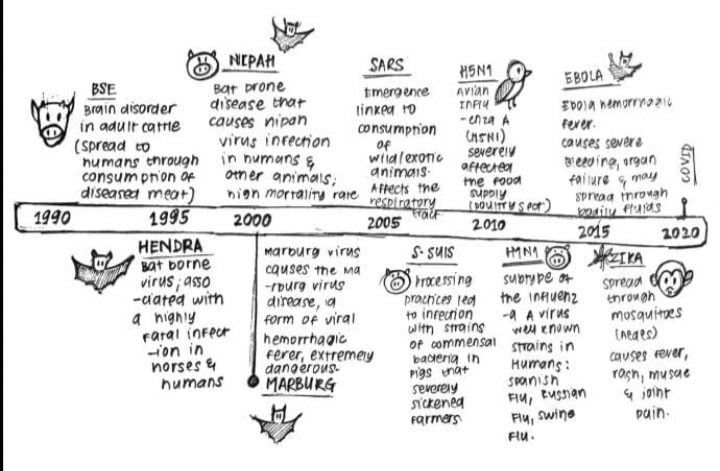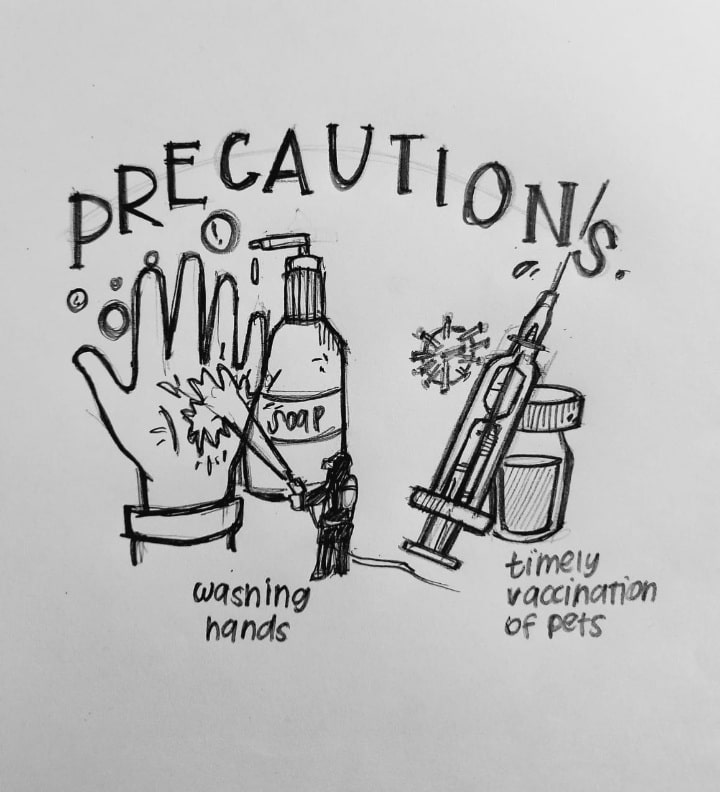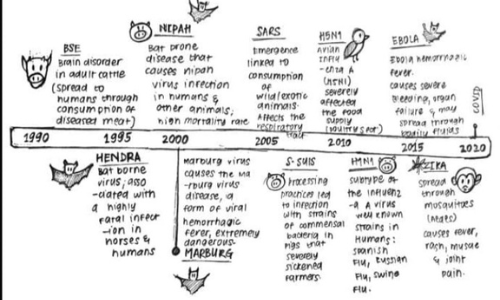Mankind currently is riddled with over 10000+ diseases. According to the Centers for Disease Control and Prevention (CDC), 60% of infectious diseases can be spread through animals and 75% of new emerging diseases in people trace their origin to animals. Globally, zoonotic diseases or zoonoses are responsible for an estimated 2.5 billion cases of human illnesses and 2.7 billion deaths per year. In addition to the loss of human life, as per the 2010 World Bank report, zoonotic diseases have caused a dent of about $200 billion to economies affected by them worldwide. There exists a multi-sectoral impact of zoonoses and thus it is incredibly important to study all the different angles and implications of these diseases, to come up with a multi-disciplinary approach toward containment and remedial treatments. But why should you, as a citizen, be concerned about zoonotic diseases? Let’s start by learning what zoonotic diseases are.

WHAT ARE ZOONOTIC DISEASES – A BRIEF HISTORY:
I’m sure a lot of you are proud pet owners and animal lovers. Animals provide warmth, comfort, companionship, fibers, and food (to all the meat lovers out there). But in addition to all the benefits animals pose to humans, they are also carriers of harmful germs capable of causing illnesses. As the gap between humans and animals closes (due to settlements, encroachment, and such), it increases the risks of these germs transferring onto humans and causing severe ailments.
The term Zoonoses is derived from the Greek word “Zoon” meaning animal and “Nosos” meaning illness. Zoonotic diseases or zoonoses are thus those diseases that are caused due to the transmission of harmful pathogens such as bacteria, fungi, and virus from animals (usually vertebrates) to humans or vice versa.
The early ancestors of humans depended on gathering of plants, wild fruit
and hunting wild animals for their survival (hunter-gatherers) which carried with it the risks of exposure to animal pathogens and cross infection, evidence of which lies in the analysis of several fossilized skeletal remains such as that of the hominins which revealed the presence of tuberculosis and chronic brucellosis.
However, according to various archaeological evidence and biological data, epidemics of zoonotic infections were most likely experienced around the ‘First Agricultural Revolution’ around 11000-9000 BCE in Southwest Asia as humans shifted towards agrarian societies that produced food instead of gathering it. Throughout history, such outbreaks have been a common occurrence for mankind, costing millions of lives due to under-developed medicinal technology. Till date, there have been 3 outbreaks of Plague, 5 outbreaks of cholera endemic to India which spread globally, Avian Influenza, Spanish Flu, Ebola, etc. Most recently, the COVID 19 outbreak in 2020 was also a zoonosis.
HOW IT GRIPS YOU

Pathogens are commonly transmitted to humans through direct contact, inhalation, ingestion, conjunctiva, or biting. Interactions with the animal through hunting, animal farming, wet markets, the exotic pet trade, and the trade of animal-based foods increase the chances of cross-species transmission. Additionally, climate changes and land use are also key factors in this transmission.
The process of cross-species transmission of pathogens has notably 5 stages:
(1) the pathogen exclusively infects animals under natural conditions.
(2) the pathogen evolves so that it can be transmitted to humans but it cannot yet sustain human to human transmission.
(3) the pathogen undergoes a couple cycles of secondary transmissions from human to human.
(4) the disease exists in animals but secondary human-to-human transmission now occurs without the involvement of an animal host.
(5) the disease occurs exclusively in humans by mutating into human-only strains.
Bacteria, protozoa, parasites, and fungi enter the body and multiply rapidly. They damage the cells and create an infection which causes symptoms of illness to occur. The incidence of disease amongst those infected, however, varies depending on the particular pathogen and individual susceptibility. Our immune system fights these pathogens and tries to eliminate them by the action of White Blood Cells and other antibodies. Viruses though, are trickier to deal with.
Viruses originating from animals sometimes manage to replicate within a human host after transmission, at which point they can mutate and evolve under the new “host constraints”. In such situations, the impending disease may be less deadly since the human immune system and the virus may eventually come to a stalemate where the host is no longer affected by the virus’s presence. However, in cases where the virus evolves inside an animal body and then infects a human host, the immunity system isn’t completely equipped to deal with the constraints under which the virus functions, thus creating a deadly situation. Viruses have been at the center stage for the last several zoonotic outbreaks and need to be studied further in-depth.
Zoonotic diseases are a growing concern due to their novel and unpredictable nature, their ability to rapidly spread across the globe, and their environmental and socio-economic implications.
HOW CAN WE DEAL WITH IT?

Managing or treating zoonoses is difficult and their eradication is nearly impossible. Precaution thus proves to be the best cure. An infection prevention and control program should be implemented before the emergence of a disease with standard precautions as an essential component that would be used to care for all patients, irrespective of their confirmed infectious status. This will equip the health sector to deal with sudden outbreaks.
Vector control management should be considered for all arthropod-borne viruses.
Countries need to establish and maintain effective collaboration between animal and human health sectors. More coordinated actions are required to reduce the risk of human infection from animals, to share disease information for early warning, and to rapidly respond to zoonotic disease outbreaks. It is important to implement a surveillance program to detect the emergence of pathogens with the potential for zoonotic transmission. Systematic collection of data to track the spread of disease, while issuing timely warnings to officials and citizens along with active follow-up responses are crucial under the circumstances of pandemics, which was something that was heavily lacking worldwide while dealing with COVID 19. Human intervention is necessary so as to reduce transmission risks, examples of which could be restrictions on inter-country transport to prevent the spread of the pathogen.
On a more personal level, it’s imperative for us to keep our hands clean by washing them with soap and water after being around animals. Simultaneously, avoid bites and scratches from animals and make sure that your pets are timely vaccinated. Learn more about ways to handle food safely – whether it’s for you, your family, pets, or any other animal. Keep yourself aware of the things happening around you and know about zoonoses.
Control of zoonotic diseases is a pivotal aspect of the health sector of any nation and is a key factor for the socio-economic backdrop of that place. Globalization has only aided in the easier transmission of pathogens – as the world gets more connected, more people risk exposure to diseases, the impact of which is felt with extreme intensity by those living in poverty or in developing countries. Organizations such as the World Health Organization (WHO), Food and Agriculture Organization (FAO), and World Organization for Animal Health (OIE) have been taking major steps in containing the spread of zoonoses in hotspots such as the middle east.
To everyone’s surprise, however, there has been a re-emergence of Monkeypox. Cases of the disease have been reported in multiple countries which are non-endemic to the causative virus. Leading scientists are unable to trace the origin of the outbreak as no travel links are established to the endemic regions.
With the number of monkeypox cases rising daily, one cannot help but wonder – “Should we be worried, and are we in for another pandemic?”
Let’s find out in the next article!
Bibliography:
https://www.cdc.gov/onehealth/basics/zoonotic-diseases.html
https://royalsocietypublishing.org/doi/10.1098/rstb.2020.0535
https://www.ncbi.nlm.nih.gov/pmc/articles/PMC1549006/
https://www.ncbi.nlm.nih.gov/pmc/articles/PMC7552289/
http://www.emro.who.int/fr/about-who/rc61/zoonotic-diseases.html
https://www.ncbi.nlm.nih.gov/pmc/articles/PMC3415616/
https://www.nature.com/articles/s41467-017-00923-8
https://www.ncbi.nlm.nih.gov/pmc/articles/PMC3729053/
https://apps.who.int/iris/bitstream/handle/10665/205227/B3228.pdf?sequence=1&isAllowed=y
. . .
Writer
Tanya Gadwal
Editor
Dhanashri Satav
Illustrator
Anushree Joshi

